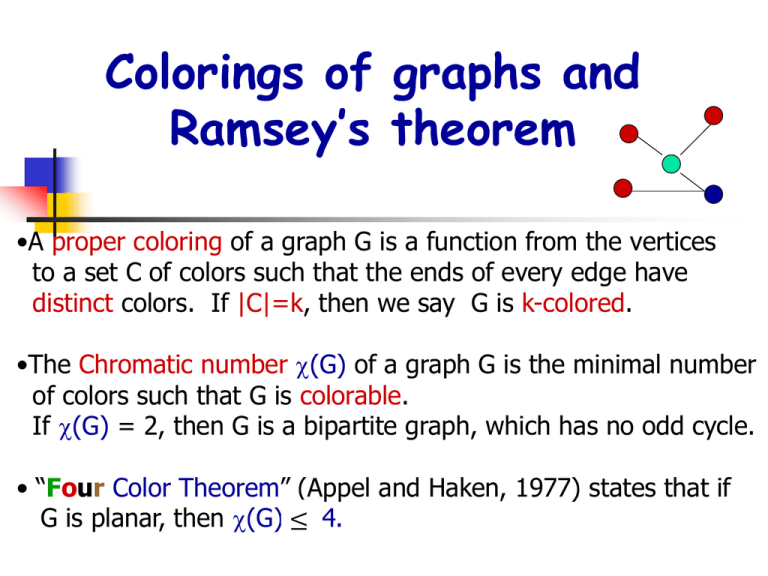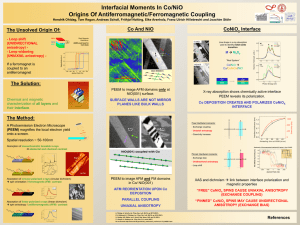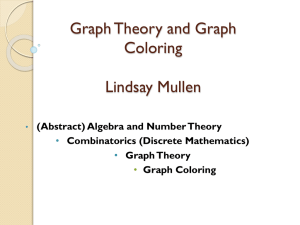x n-1
advertisement

Colorings of graphs and
Ramsey’s theorem
•A proper coloring of a graph G is a function from the vertices
to a set C of colors such that the ends of every edge have
distinct colors. If |C|=k, then we say G is k-colored.
•The Chromatic number (G) of a graph G is the minimal number
of colors such that G is colorable.
If (G) = 2, then G is a bipartite graph, which has no odd cycle.
• “Four Color Theorem” (Appel and Haken, 1977) states that if
G is planar, then (G) ≤
4.
Applications of graph coloring:
Scheduling Final Exams: How can the final exams at
a university be scheduled so that no student has two
exams at the same time?
Frequency Assignments: Suppose no two TV stations
can operate within 220km on the same channel.
How can the assignment of channels be modeled by
graph coloring?
Index Register: In efficient compilers the execution
of loops is speeded up when frequently used
variables are stored temporarily in index registers in
the CPU, instead of regular memory. For a given
loop, how many index registers are needed?
........
p2.
Thm 3.1.(Brooks’s Theorem) Let d 3 and let G be a graph where all
vertices have degree ≤ d such that Kd+1 is not a subgraph of G.
Then (G) ≤ d.
Pf: We prove by contradiction and with the re-coloring technique.
Let G be a counterexample with the minimum number of vertices. Let
x be a vertex with neighbors x1,…, xl, l
≤ d. Let H= G – {x}. Then
H has a d-coloring, since G is a minimal graph without d-coloring.
Let 1,…, d be the colors. If one of the colors is not used in x’s
neighbors, then we’re done. Why? Thus l=d and assume xi has
color i.
Let Hij be a subgraph of H with colors i and j.
xi and xj must be in the same connected component of Hij (say Cij).
Why?
p3.
Can the first i have 2 neighbors with j?
H=G-{x}
1
1
2
2
<= d-2
l l<=d?
d
x
i
i
j
j
i
j
j
i Is it possible?
p4.
j
k
i
i
k
k
j
i
Moreover, the component is a simple path from xi to xj in
Hij. Since if 2 neighbors of xi in H had the same color j,
then the other neighbors of xi in H would have at most
d-2 different colors. Then we could recolor xi, which is
impossible. Why?
Suppose y is the first vertex on the path from xi to xj in
Cij with deg 3. Then the neighbors of y in H use at
most d-2 colors, so we can recolor y such that xi and xj
are not connected in Hij, which is impossible. Why?
Thus no such y exists and Cij is a path.
Suppose z is in Cij and Cik but it is not xi. Then z has two
neighbors with color j and two with color k. Again the
neighbor of z in H use at most d-2 colors. Re-coloring z,
we have another contradiction. So Cij Cik ={xi}.
p5.
By the assumption that G has no Kd+1 as subgraph,
there are 2 neighbors of x, say x1 and x2, that are
not adjacent. Let a be the neighbor of x1 with color
2. Interchange the colors
1 and 3 on C13. Thus a is in
x1 C13
C’23 and is also in C’12.
x3
Thus C’12 C’23 {x2}.
a
x
C23
Contradiction!
C12
x2
p6.
Proof 2 of Brooks Theorem:
Problem 3A: Fix d≥ 3. Let H be a simple graph with all
degree ≤ d which cannot be d-colored and which is
minimal subject to these properties. (1) Show that H is
connected after deleting a vertex. (2) Then show that if
partition V(H) into sets X and Y with |Y| ≥ 3, then there
are at least 3 vertices a, b, c in Y each of which is
adjacent to at least one vertex in X.
Proof 2: Let d and H as in Problem 3A. If H is not
complete, there are vertices x1,xn-1,xn so that x1 is
adjacent to xn-1 and xn but the last two are not adjacent.
x1
xn-1
xn
Number the rest n-3 vertices such that each xk, k>1
is adjacent to at least one of xi with i< k.
I.e. when x1,...,xk have been chosen k< n-2, choose
xk+1 to be any vertex other than xn-1 or xn
adjacent to one of x1,..xk. Why possible?
p7.
Proof 2 of Brooks Theorem:
Once the above is done, d-color the vertices starting
at the end of the sequence– assigning xn and xn-1 the
same color.
x1
x2
xk
xk+1
xn-1
xn
Inductively and finally, there is one color available
If x ,..., xn have been colored properly, then xk
for x1. Why?k+1
connects to at most d-1 of them.
p8.
Thm 3.2. If the edges of Kn are colored red or blue, and ri,
i=1,…, n, denotes the number of red edges with vertex i
as an endpoint, and if T is the number of monochromatic
triangles, then
n 1 n
T=
r ( n 1 r ).
3
Pf:
2
i
i 1
i
..
ri red edges
Corollary:
n
T
3
n
2
n 1 2
( 2 ) .
i
Ramsey number N( p, q; 2):至少需要幾人,其中才會有
p個人彼此都認識或有q個人彼此都不認識?
N( 3, 2; 2) =3.
N( 3, 3; 2) =6. Why?
Ramsey number N( p, q; 2):至少需要幾人,其中才會有
p個人彼此都認識或有q個人彼此都不認識?
Claim: N(p,q;2) ≤ N(p-1,q; 2) + N(p,q-1; 2).
Proof:
•Let n = N(p-1,q; 2) + N(p,q-1; 2). Consider a graph
with n vertices and v be one of the vertices.
•Color the edges of the graph with red and blue colors
By induction the red neighbors has p vertices with
in an arbitrary way.
blue edges only or q-1 vertices with red edges only.
Red neighbors >= N(p,q-1;2).
v
or
Similarly, by induction, the blue neighbors has p-1 vertices
with blue edges only or q vertices with red edges only.
Blue neighbors >= N(p-1,q;2).
Ramsey number N( p, q; 2):至少需要幾人,其中才會有p個人
彼此都認識或有q個人彼此都不認識?
•By observing the binomial coefficients C(n,k), we know
C(n,k)= C(n-1,k) + C(n-1, k-1).
•By the claim, we have N(p,q;2) ≤ N(p-1,q; 2) + N(p,q-1; 2).
•We prove Thm 3.4. N(p,q;2)
≤
C(p+q-2, q-1). By induction,
assume N(p-1,q; 2)
≤
C(p+q-3, q-1) and
N(p,q-1; 2)
≤
C(p+q-3, q-2).
•Then N(p,q;2) ≤ N(p-1,q; 2) + N(p,q-1; 2)
≤
C(p+q-3, q-1) + C(p+q-3, q-2)
= C(p+q-2, q-1)
What is the value of N(p,q:2) in general?
N(3,4;2) ≤ 9, by Thm 3.4 and Problem 3C.
To show the equality holds, we find a coloring on K8
0
without red K3 and blue K4.
7
• Similarly, we have (Problem 3D)
N(4,4;2)=18, N(3,5;2)=14.
6
2
3
5
• With a lot more work, it is known that:
N(3,6;2)=18, N(3,7;2)=23, N(3,8; 2)=28
N(3,9;2)=36, N(4,5;2)=25. There is no other
larger N(p,q;2) value known!
1
4
"Imagine an alien force, vastly more
powerful than us landing on Earth
and demanding the value of
N(5, 5;2) or they will destroy our
planet. In that case, we should
marshal all our computers and all
our mathematicians and attempt
to find the value. But suppose,
instead, that they asked for
N(6, 6;2), we should attempt to
destroy the aliens".
- Paul Erdős
p14.
p, 1 2
q
3
4
5
6
7
8
9
10
已知的Ramsey Numbers
1
1 1
1
1
1
1
1
1
1
1
2
1 2
3
4
5
6
7
8
9
10
3
1 3
6
9
14
18
23
28
36
40–43
4
1 4
9
18
25
35–41
49–61
56–84
73–115
92–149
5
1 5
14
25
43–49
58–87
80–143
101–216
125–316
143–442
6
1 6
18
35–41
58–87
102–165
113–298
127–495
169–780
179–1171
7
1 7
23
49–61
80–143
113–298
205–540
216–
1031
233–1713
289–2826
8
1 8
28
56–84
101–
216
127–495
216–
1031
282–
1870
317–3583
≤ 6090
9
1 9
36
73–
115
125–
316
169–780
233–
1713
317–
3583
565–6588
580–
12677
1
0
1 1
0
40–
43
92–
149
143–
442
179–1171 289–
2826
≤ 6090
580–12677 798–
23556
p15.
By Thm 3.4 we know N(p,p:2) ≤ 22p-2.
Thm3.5. N(p,p;2) 2p/2.
Kp
Pf: Randomly color a Kn. There are 2 C(n,2) different ways of
coloring the edges blue or red.
C(n,2)-C(p,2)+1 colorings for which
Fix a subgraph Kp. There are 2
Kp is monochromatic.
C(n,2)-C(p,2)+1 colorings that some K
There are at most C(n, p) 2
p
is monochromatic. If this number is less than the total number
of colorings, then there exist colorings with no monochromatic
Kp.
p
p/2, then
Since C(n,p) < n /p!, if n< 2
C(n, p) 2 C(n,2)-C(p,2)+1 < 2C(n,2) .
-C(p,2)+1< (np/p!) 2-C(p,2)+1
Because C(n, p) 2
< (2p*p/p!) 2-C(p,2)+1 < 1.
Thm 3.6. (Lovász Local lemma) Let G be some dependency
graph for the events A1,…, An. Suppose that Pr[Ai] ≤ p,
i=1,…,n and that every vertex of G has degree ≤ d. If 4dp <
1, then
A i 0.
Pf: First show that for every subset {i 1 , ..., i m },
P r[A i1 | A i 2 ...A i m ]
1
2d
. For convenience take i j = j.
It is trivial for m = 1 and for m = 2 w e have:
P r[A 1 | A 2 ]
p
1-p
1 / 4d
1 1 / 4d
1
4d 1
1
.
2d
p17.
P r[A 2 ...A q | A q+ 1 ...A m ] 1 P r[A 2 ... A q | A q+ 1 ...A m ]
W e proceed by induc tion
on m .
q
1 toP2,3,...,
r[A i | Aqq+ 1only.
...A m ] 1
S uppose 1 is adjacent
i= 2
W e have P r[A 1 | A 2 ...A m ]
P r[A 1 ...A n ]
P r[A 1 ]
1
q 1
1 / 2.
2d
P r[A 1 A 2 ...A q | A q+ 1 .. .A m ]
.
P r1[A
...A1 ...A
P r[A
A 2 2A...A
+ 1r[A
m ] n]
3 ] q | A qP
...
P r[A 1 ]
P r[A 1 A 2 ]
P r [ A 1 ...A n-1 ] 1
P r[A 1 A 2 ]
T he num erat or is at m ost P r[A 1 | A q+ 1 . ..A m ] P r[A 1 ]
.
P r[A 1 ] P r[A 2 | A 1 ] P r[A 3 | A 1 A 2 ] ... P r[ A n | A 14d
...A n-1 ]
B y i nduction hypothesis, the denom inator is at least
q
1- P r[A i | A q+ 1 ...A m ] 1
i= 2
q 1
1 / 2.
2d
T hus w e p rove the claim .
n
N ow P r[A 1 ...A n ]
i= 1
P r[A i | A 1 ...A i-1 ] (1
1
2d
) 0.
n
Thm 3.7. N(p,p;2)c p 2p/2, where c is a constant.
Pf. Consider Kn and color the edges randomly.
For any set S of k vertices let AS be the event that the
subgraph on S is monochromatic. Pr[ AS ] = 21-C(k,2).
Let T be another k-set. AS and AT are dependent iff |S
T| 2, i.e. the subgraphs on S and T share at least one
common edge.
The degree d is at most C(k,2) C(n, k-2).
1-C(k,2)C(k,2)C(n, k-2)<1, then none of A will
If 4 2
S
happen.
k/2.
By some calculation, we have n < c k 2
This means we will need larger n to have any AS
happen. Let k=p. we prove the Thm. □
p19.
F. R. Ramsey (1902-1928) a logician
Thm 3.3. (Ramsey’s theorem 1930) Let r 1 and qi r,
i=1,2,…,s be given. There exists a minimal positive
number N(q1,…,qs; r) such that:
Let S be a set with n elements.
Suppose that all C(n,r) r-subsets of S are divided into s
mutually exclusive families T1,…, Ts (colors).
Then if n N(q1,…,qs; r) there is an i [s] and some
qi-subset of S for which every r-subset of these qi is in
Ti.
We will show the case when s=2.
(a) N(p,q;1)= p+q-1, Why?
(b) N( p, r; r)=p and N( r, q; r)=q, for p, q r.
p20.
Proof of Thm 3.3.
By induction on r, we assume it is true for up to r-1.
Use induction on p+q, using (b).
Define p1=N( p-1, q; r) and q1=N( p, q-1; r).
Let S be a set with n elements, where
n 1+ N(p1, q1; r-1).
Let the r-subsets of S be colored with red and blue colors.
Let a be an arbitrary element of S and S’=S-{a}.
Define a coloring of the (r-1)-subsets of S’ by giving any (r1)-subset X S’ the same color as X {a}.
By ind hyp, S’ either has a subset A of size p1 such that all its
(r-1)-subsets are red or a subset B of size q1 with all its (r-1)subsets colored blue. WLOG, suppose the first case happens.
Then A has N(p-1, q;r) elements.
p21.
A has N(p-1, q; r) elements. There are two possibilities.
(1) A has a subset of q elements with all its r-subsets blue, in
which we are done.
(2) A has a subset A’ of size p-1 with all its r-subsets red.
The set A’ {a} also has this property, since A’ A. This
proves the theorem and we have:
N(p, q; r) ≤ N( p1, q1; r-1) +1
= N( N(p-1, q; r) , N(p, q-1; r) ; r-1) +1.
□
Taking r=2, we can obtain
N(p, q; 2) ≤ N(p-1, q; 2) + N(p, q-1; 2).
N(p, q; r) ≤ N( N(p-1, q; r), N(p, q-1; r); r-1) +1.
r-1
N(p-1, q; r) elements.
a
r-1
N(p,q-1;r) elements.
N(p, q; 2) ≤ N(p-1, q; 2) + N(p, q-1; 2).
p-1
q-1
Problem 3C: The equality cannot hold, if
the right hand side are both even.
q
p
deg=N(p-1,q;2)+N(p,q-1;2)-1
p23.
An application of Ramsey’s Theorem
Theorem 3.8: For a given n, there is an integer N(n) such that
any collection of N> N(n) points in the plane, no three on a line,
has a subset of n points forming a convex n-gon.
Proof: (1) 觀察平面上n個點,其中任何三點不共線。這n點
將形成凸n邊型若且唯若 其中任意四點形成凸四邊型。
(2)令N(n)=N(n,n;3) 。然後將這N(n)個點由1
編號並將任意三點形成的三角型塗上紅色如
果這三點的編號由小到大是順時鐘方向;否則
塗成藍色。由N(n,n;3)的定義知存在n個點,其中任意三個點形
成的三角型都是紅色的。
2
1
7
3
1
5
p24.
考慮這n個點中的任意4點,試問可否產生下列情形?也
就是說點d是否可以落在一紅色的三角型?
b
其中假設 a < b < c。
c
d
由圖可知 a < d < c,
a
因為三角型adc為紅色。同理 a < b < d。
但由此可推論出 b < d < c,這表示
三角型bdc應當塗成藍色。
故得到矛盾。所以得知不可能有上述的情況發生,
也就是說任意四點都會形成凸四邊型。
由(1)得知這n個點會形成一凸n邊型。
p25.








